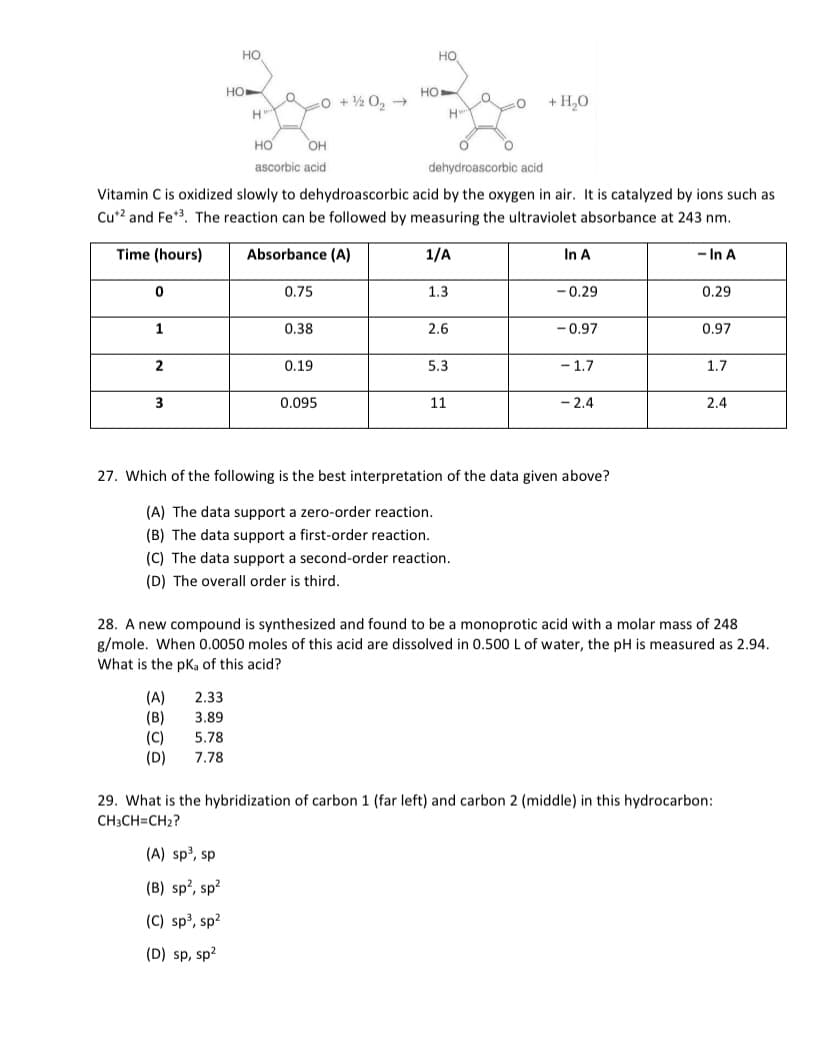acid Vitamin C is oxidized slowly to dehydroascorbic acid by the oxygen in air. It is catalyzed by ions such as Cu*? and Fe*. The reaction can be followed by measuring the ultraviolet absorbance at 243 nm.
acid Vitamin C is oxidized slowly to dehydroascorbic acid by the oxygen in air. It is catalyzed by ions such as Cu*? and Fe*. The reaction can be followed by measuring the ultraviolet absorbance at 243 nm.
Chemistry: The Molecular Science
5th Edition
ISBN:9781285199047
Author:John W. Moore, Conrad L. Stanitski
Publisher:John W. Moore, Conrad L. Stanitski
Chapter11: Chemical Kinetics: Rates Of Reactions
Section: Chapter Questions
Problem 25QRT
Related questions
Question

Transcribed Image Text:но
HO
Но
HO
co + ½ 0, -
+ H,O
H"
H
но
Он
ascorbic acid
dehydroascorbic acid
Vitamin C is oxidized slowly to dehydroascorbic acid by the oxygen in air. It is catalyzed by ions such as
Cu*2 and Fe*3. The reaction can be followed by measuring the ultraviolet absorbance at 243 nm.
Time (hours)
Absorbance (A)
1/A
In A
- In A
0.75
1.3
-0.29
0.29
1
0.38
2.6
-0.97
0.97
0.19
5.3
- 1.7
1.7
3
0.095
11
- 2.4
2.4
27. Which of the following is the best interpretation of the data given above?
(A) The data support a zero-order reaction.
(B) The data support a first-order reaction.
(C) The data support a second-order reaction.
(D) The overall order is third.
28. A new compound is synthesized and found to be a monoprotic acid with a molar mass of 248
g/mole. When 0.0050 moles of this acid are dissolved in 0.500L of water, the pH is measured as 2.94.
What is the pk, of this acid?
(A)
(В)
(C)
(D)
2.33
3.89
5.78
7.78
29. What is the hybridization of carbon 1 (far left) and carbon 2 (middle) in this hydrocarbon:
CH3CH=CH2?
(A) sp, sp
(B) sp?, sp?
(C) sp3, sp2
(D) sp, sp?
Expert Solution
This question has been solved!
Explore an expertly crafted, step-by-step solution for a thorough understanding of key concepts.
This is a popular solution!
Trending now
This is a popular solution!
Step by step
Solved in 2 steps

Knowledge Booster
Learn more about
Need a deep-dive on the concept behind this application? Look no further. Learn more about this topic, chemistry and related others by exploring similar questions and additional content below.Recommended textbooks for you

Chemistry: The Molecular Science
Chemistry
ISBN:
9781285199047
Author:
John W. Moore, Conrad L. Stanitski
Publisher:
Cengage Learning

Chemistry by OpenStax (2015-05-04)
Chemistry
ISBN:
9781938168390
Author:
Klaus Theopold, Richard H Langley, Paul Flowers, William R. Robinson, Mark Blaser
Publisher:
OpenStax

Chemistry & Chemical Reactivity
Chemistry
ISBN:
9781337399074
Author:
John C. Kotz, Paul M. Treichel, John Townsend, David Treichel
Publisher:
Cengage Learning

Chemistry: The Molecular Science
Chemistry
ISBN:
9781285199047
Author:
John W. Moore, Conrad L. Stanitski
Publisher:
Cengage Learning

Chemistry by OpenStax (2015-05-04)
Chemistry
ISBN:
9781938168390
Author:
Klaus Theopold, Richard H Langley, Paul Flowers, William R. Robinson, Mark Blaser
Publisher:
OpenStax

Chemistry & Chemical Reactivity
Chemistry
ISBN:
9781337399074
Author:
John C. Kotz, Paul M. Treichel, John Townsend, David Treichel
Publisher:
Cengage Learning


Chemistry
Chemistry
ISBN:
9781305957404
Author:
Steven S. Zumdahl, Susan A. Zumdahl, Donald J. DeCoste
Publisher:
Cengage Learning

Chemistry: An Atoms First Approach
Chemistry
ISBN:
9781305079243
Author:
Steven S. Zumdahl, Susan A. Zumdahl
Publisher:
Cengage Learning